Related Research Articles
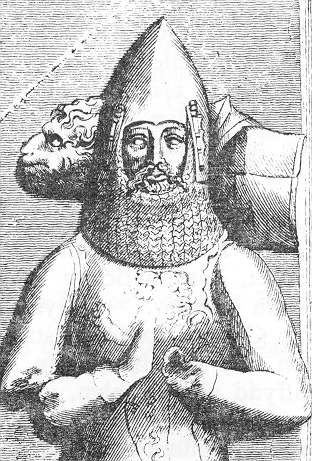
Rhys ap Gruffydd or ap Gruffudd was the ruler of the kingdom of Deheubarth in south Wales from 1155 to 1197. Today, he is commonly known as The Lord Rhys, in Welsh Yr Arglwydd Rhys, although this title may have not been used in his lifetime. He usually used the title "Proprietary Prince of Deheubarth" or "Prince of South Wales", but two documents have been discovered in which he uses the title "Prince of Wales" or "Prince of the Welsh". Rhys was one of the most successful and powerful Welsh princes, and, after the death of Owain Gwynedd of Gwynedd in 1170, the dominant power in Wales.
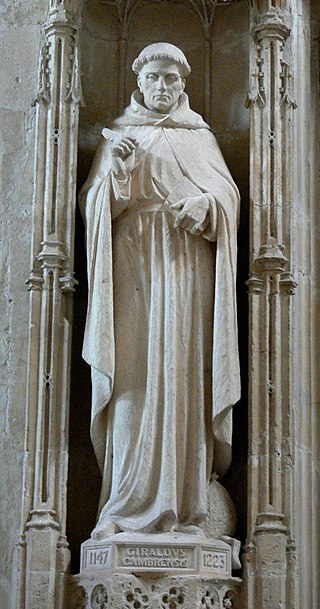
Gerald of Wales was a Cambro-Norman priest and historian. As a royal clerk to the king and two archbishops, he travelled widely and wrote extensively. He studied and taught in France and visited Rome several times, meeting the Pope. He was nominated for several bishoprics but turned them down in the hope of becoming Bishop of St Davids, but was unsuccessful despite considerable support. His final post was as Archdeacon of Brecon, from which he retired to academic study for the remainder of his life. Much of his writing survives.
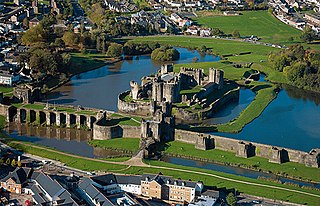
Caerphilly is a town and community in Wales. It is situated at the southern end of the Rhymney Valley.
Llywelyn Bren, or Llywelyn ap Gruffudd ap Rhys / Llywelyn ap Rhys or in English: Llywelyn of the Woods. He was a nobleman who led a 1316 revolt in Wales in the reign of King Edward II of England. It marked the last serious challenge to English rule in Wales until the attempts of Owain Lawgoch to invade with French support in the 1370s. Hugh Despenser the Younger's unlawful execution of Llywelyn Bren helped to lead to the eventual overthrow of both Edward II and Hugh.

William FitzRobert, 2nd Earl of Gloucester was the son and heir of Sir Robert de Caen, 1st Earl of Gloucester, and Mabel FitzRobert of Gloucester, daughter of Robert Fitzhamon, and nephew of Empress Matilda.
Caradog ap Gruffydd was a Prince of Gwent in south-east Wales in the time of Gruffydd ap Llywelyn and the Norman conquest, who reunified his family's inheritance of Morgannwg and made repeated attempts to reunite southern Wales by claiming the inheritance of the Kingdom of Deheubarth.

The Battle of Crug Mawr, sometimes referred to as the Battle of Cardigan, took place in September or October 1136, as part of a struggle between the Welsh and Normans for control of Ceredigion, West Wales.
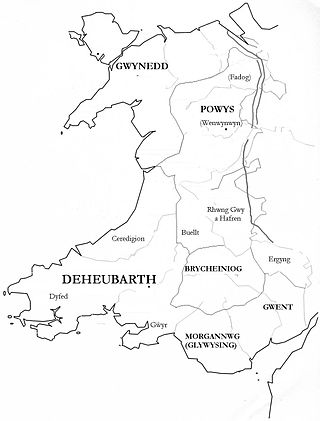
Gwent was a medieval Welsh kingdom, lying between the Rivers Wye and Usk. It existed from the end of Roman rule in Britain in about the 5th century until the Norman invasion of Wales in the 11th century. Along with its neighbour Glywyssing, it seems to have had a great deal of cultural continuity with the earlier Silures, keeping their own courts and diocese separate from the rest of Wales until their conquest by Gruffydd ap Llywelyn. Although it recovered its independence after his death in 1063, Gwent was the first of the Welsh kingdoms to be overrun following the Norman conquest.
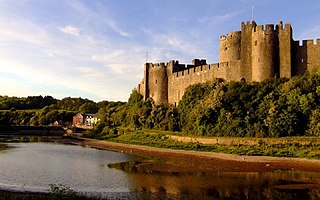
Gerald de Windsor, aliasGerald FitzWalter, was an Cymro-Norman lord who was the first Castellan of Pembroke Castle in Pembrokeshire. Son of the first Norman-French Constable of Windsor Castle, and married to a Welsh Princess daughter of the King of Deheubarth, he was in charge of the Norman forces in south-west Wales. He was also steward and governor for the Norman magnate Arnulf de Montgomery. His descendants were the FitzGerald dynasty, as well as the FitzMaurice, De Barry, and Keating dynasties of Ireland, who were elevated to the Peerage of Ireland in the 14th century. He was also the ancestor of the prominent Carew family, of Moulsford in Berkshire, the owners of Carew Castle in Pembrokeshire and of Mohuns Ottery in Devon.

Bernard de Neufmarché, also Bernard of Newmarket or Bernard of Newmarch was the first of the Norman conquerors of Wales. He was a minor Norman lord who rose to power in the Welsh Marches before successfully undertaking the invasion and conquest of the Kingdom of Brycheiniog between 1088 and 1095. Out of the ruins of the Welsh kingdom he created the Anglo-Norman lordship of Brecon.
This article is about the particular significance of the century 1101–1200 to Wales and its people.

Senghenydd is a former mining village in the community of Aber Valley in South Wales, approximately four miles northwest of the town of Caerphilly. Historically within the county of Glamorgan, it is now situated in the county borough of Caerphilly. In the United Kingdom Census 2001, the population of the Aber Valley was 6,696. The wind farm proposed in 2023 would see the village surrounded by turbines up to 200 metres high.
Sibyl de Neufmarché, Countess of Hereford, suo jure Lady of Brecknock, was a Cambro-Norman noblewoman, heiress to one of the most substantial fiefs in the Welsh Marches. The great-granddaughter of Gruffydd ap Llywelyn, king of Wales, Sibyl was also connected to the nobility of England and Normandy. Sibyl inherited the titles and lands of her father, Bernard de Neufmarché, Lord of Brecon, after her mother, Nest ferch Osbern, had declared her brother Mahel to have been illegitimate. Most of these estates passed to Sibyl's husband, Miles de Gloucester, 1st Earl of Hereford, as her dowry. Their marriage had been arranged personally by King Henry I of England in the spring of 1121. Sibyl, with her extensive lands, was central to the King's plans of consolidating Anglo-Norman power in south-east Wales by the merging of her estates with those of Miles, his loyal subject on whom he relied to implement Crown policy.
Einion ap Collwyn, was a Welsh prince and warrior supposed to have existed in the eleventh century. Not mentioned in medieval chronicles, he is the subject of possibly legendary or fictional writings from the sixteenth century onwards, the oldest surviving report being that of the Tudor antiquary John Leland. Some Welsh family genealogies claimed descent from Einion.

Morgraig Castle is a ruined castle, which lies close to the southern borders of the county borough of Caerphilly, overlooking Cardiff in Wales. It was built in the 13th century, but there is some debate as to who actually built the castle, either Gilbert de Clare or the Lord of Senghennydd. The castle appears to have never been occupied or completed. It is now a scheduled monument and a Grade II listed building.

The Descriptio Cambriae or Descriptio Kambriae is a geographical and ethnographic treatise on Wales and its people dating from 1193 or 1194. The Descriptio’s author, variously known as Gerald of Wales or as Giraldus Cambrensis, was a prominent churchman of Welsh birth and mixed Norman-Welsh ancestry. It is divided into two books, the first concentrating on the virtues of the Welsh people, and the second on their faults.
Morgan ap Hywel was Lord of Gwynllwg in Wales from about 1215 until his death in 1245, and for many years laid claim to the lordship of Caerleon, which had been seized by the Earl of Pembroke. For most of his life he was at peace with the English, at a time when there were periodic revolts by Welsh leaders against their rule. He may have participated in a crusade between 1227 and 1231.
Morgan ab Owain was a Welsh king and Lord of Caerleon. He was a son of Owain Wan and thus a grandson of Caradog ap Gruffydd, the last Welsh king of Gwent.
References
- ^ Itinerarium Cambriae, Giraldus Cambrensis: book 1, chapter 6. Published by Penguin, ISBN 0-14-044339-8 pp. 122–123 in that edition.
- ^ "The Norman Conquest". Caerphilly Castle. Retrieved 13 November 2005.[ dead link ]
- ^ "The natural landscape and geological background". Merthyr Tydfil Historic Landscape Characterisation. Archived from the original on 10 August 2005. Retrieved 13 November 2005.